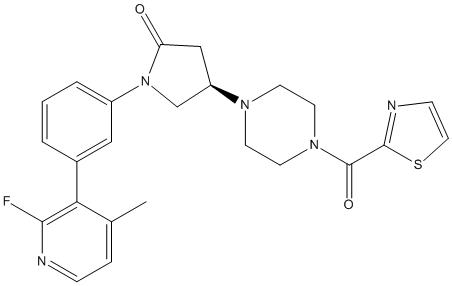T-401
can be fluorinated with 18F to form a PET radio ligand
General
Type : Pyrrolidine,Piperazine,PET probe,Sulfur Compound
Chemical_Nomenclature : 1-[3-(2-fluoro-4-methylpyridin-3-yl)phenyl]-4-[4-(1,3-thiazole-2-carbonyl)piperazin-1-yl]pyrrolidin-2-one
Canonical SMILES : CC1=C(C(=NC=C1)F)C2=CC(=CC=C2)N3CC(CC3=O)N4CCN(CC4)C(=O)C5=NC=CS5
InChI : InChI=1S\/C24H24FN5O2S\/c1-16-5-6-26-22(25)21(16)17-3-2-4-18(13-17)30-15-19(14-20(30)31)28-8-10-29(11-9-28)24(32)23-27-7-12-33-23\/h2-7,12-13,19H,8-11,14-15H2,1H3
InChIKey : BSDIMVPELJZNRU-UHFFFAOYSA-N
Other name(s) : SCHEMBL20695508
MW : 465.5
Formula : C24H24FN5O2S
CAS_number :
PubChem : 137456219
UniChem : BSDIMVPELJZNRU-UHFFFAOYSA-N
IUPHAR :
Wikipedia :

Target
Families : T-401 ligand of proteins in family: Monoglyceridelipase_lysophospholip
Stucture :
Protein : human-MGLL
References (3)
| Title : Binding of the monoacylglycerol lipase (MAGL) radiotracer [(3)H]T-401 in the rat brain after status epilepticus - Mikkelsen_2024_Neurochem.Int__105717 |
| Author(s) : Mikkelsen JD , Aripaka SS , Egilmez CB , Pazarlar BA |
| Ref : Neurochem Int , :105717 , 2024 |
| Abstract : Mikkelsen_2024_Neurochem.Int__105717 |
| ESTHER : Mikkelsen_2024_Neurochem.Int__105717 |
| PubMedSearch : Mikkelsen_2024_Neurochem.Int__105717 |
| PubMedID: 38447759 |
| Gene_locus related to this paper: human-MGLL |
| Title : First-in-human in vivo undefined imaging and quantification of monoacylglycerol lipase in the brain: a PET study with (18)F-T-401 - Takahata_2022_Eur.J.Nucl.Med.Mol.Imaging__ |
| Author(s) : Takahata K , Seki C , Kimura Y , Kubota M , Ichise M , Sano Y , Yamamoto Y , Tagai K , Shimada H , Kitamura S , Matsuoka K , Endo H , Shinotoh H , Kawamura K , Zhang MR , Takado Y , Higuchi M |
| Ref : Eur J Nucl Med Mol Imaging , : , 2022 |
| Abstract : Takahata_2022_Eur.J.Nucl.Med.Mol.Imaging__ |
| ESTHER : Takahata_2022_Eur.J.Nucl.Med.Mol.Imaging__ |
| PubMedSearch : Takahata_2022_Eur.J.Nucl.Med.Mol.Imaging__ |
| PubMedID: 35022846 |
| Gene_locus related to this paper: human-MGLL |
| Title : Design, Synthesis, and Evaluation of (4 R)-1-{3-[2-((18)F)Fluoro-4-methylpyridin-3-yl]phenyl}-4-[4-(1,3-thiazol-2-ylcarbo nyl)piperazin-1-yl]pyrrolidin-2-one ([(18)F]T-401) as a Novel Positron-Emission Tomography Imaging Agent for Monoacylglycerol Lipase - Hattori_2019_J.Med.Chem_62_2362 |
| Author(s) : Hattori Y , Aoyama K , Maeda J , Arimura N , Takahashi Y , Sasaki M , Fujinaga M , Seki C , Nagai Y , Kawamura K , Yamasaki T , Zhang MR , Higuchi M , Koike T |
| Ref : Journal of Medicinal Chemistry , 62 :2362 , 2019 |
| Abstract : Hattori_2019_J.Med.Chem_62_2362 |
| ESTHER : Hattori_2019_J.Med.Chem_62_2362 |
| PubMedSearch : Hattori_2019_J.Med.Chem_62_2362 |
| PubMedID: 30753069 |
| Gene_locus related to this paper: human-MGLL |